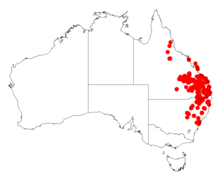Acacia juncifolia
Acacia juncifolia, commonly known as rush-leaf wattle,[1] is a shrub or tree belonging to the genus Acacia and the subgenus Phyllodineae that is endemic to north eastern Australia.
| Rush-leaf wattle | |
|---|---|
.jpg) | |
| Scientific classification | |
| Kingdom: | Plantae |
| Clade: | Tracheophytes |
| Clade: | Angiosperms |
| Clade: | Eudicots |
| Clade: | Rosids |
| Order: | Fabales |
| Family: | Fabaceae |
| Clade: | Mimosoideae |
| Genus: | Acacia |
| Species: | A. juncifolia |
| Binomial name | |
| Acacia juncifolia | |
 | |
| Occurrence data from AVH | |
Description
The shrub or tree typically grows to a height of 3 metres (9.8 ft) and has slender glabrous, reddish-brown [2] glabrous branchlets thare are more or less terete with dark grey to blackish or brownish grey coloured bark. Like most species of Acacia it has phyllodes rather than true leaves. The evergreen, glabrous and rigid phyllodes have a linear shape and are straight to slightly curved. The phyllodes have a length of 7 to 20 cm (2.8 to 7.9 in) and a width of around 1 m (3 ft 3 in) and a reasonably prominent midvein. It blooms between June and November.[1] The simple inflorescences occur singly on racemes with an axis length of 1 to 2 mm (0.039 to 0.079 in) in pairs or singly in the axils eith spherical flower-heads containing 20 to 30 light golden to deep golden coloured flowers. Follwijg flowering seed pods form . that are prominently raised over each of the seeds. The glabrous, firmly chartaceous to thinly coriaceous, dark red-brown coloured pods have a length up to {cvt|10|cm}} and a width of 3 to 4 mm (0.12 to 0.16 in). The seeds are arranged longitudinally within the pods. The dull mottle yellow and black seeds have an oblong-elliptic shape with a length of 3 to 4.5 mm (0.12 to 0.18 in).[2]
Taxonomy
The specific epithet is taken from the Latin words juncus meaning rush and folium meaning leaf in reference to the rush-like appearance of the phyllodes. A. juncifolia has a similar appearance to Acacia calamifolia.[1] Two subspecies are known:
- Acacia juncifolia subsp. juncifolia
- Acacia juncifolia subsp. serpentinicola[2]
Distribution
It is native to an area in southern Queensland around Port Clinton in the north extending into New South Wales to around Glenbrook and extending to about 500 km (310 mi) inland.[2] It is usually a part of dry sclerophyll forest and woodland communities growing well in sandy soils. In New South Wales it is extends north from around Glenbrook and as far west as Gilgandra.[1]
See also
References
- "Acacia juncifolia Benth". PlantNet. Royal Botanic Garden, Sydney. Retrieved 26 June 2020.
- "Acacia juncifolia". World Wide Wattle. Western Australian Herbarium. Retrieved 14 May 2019.